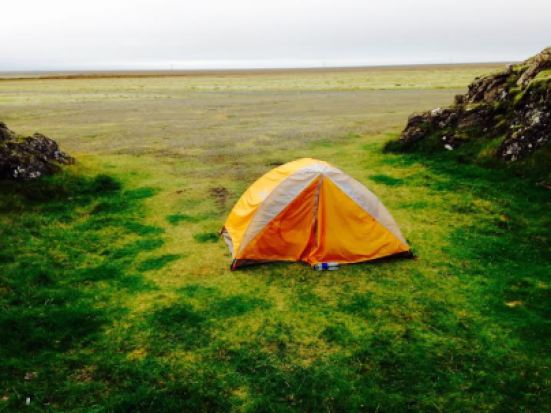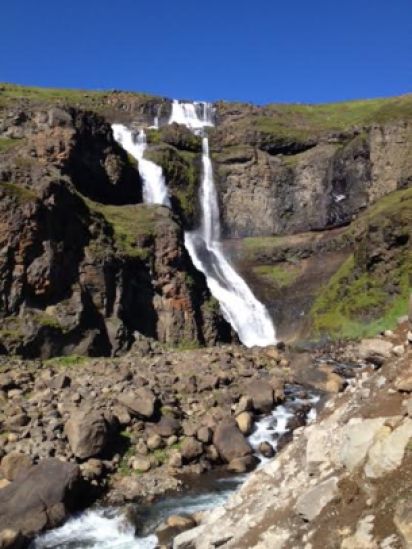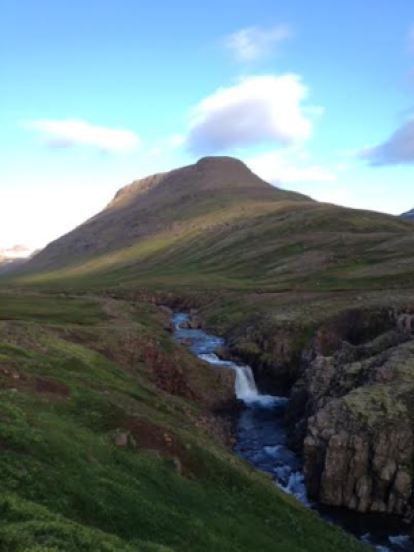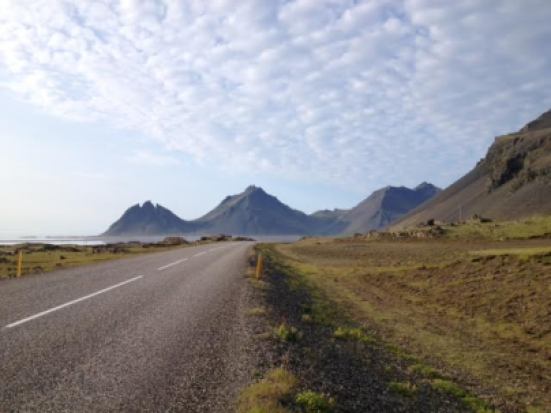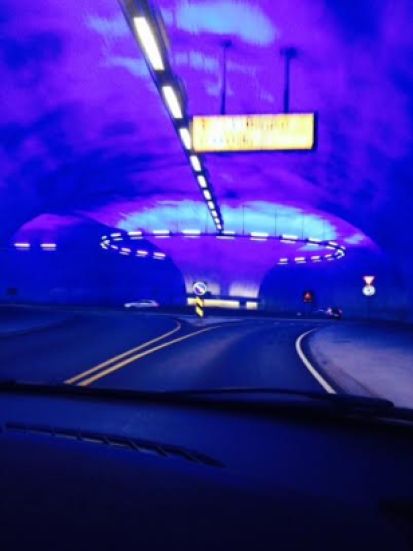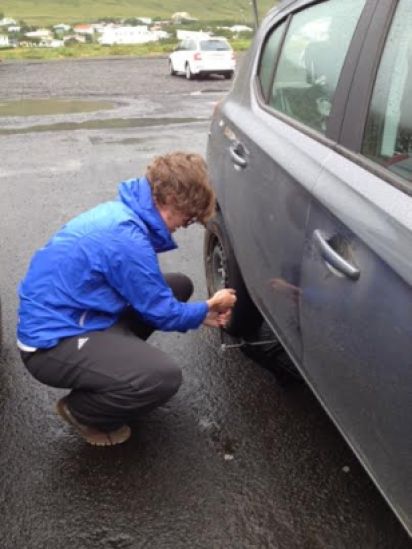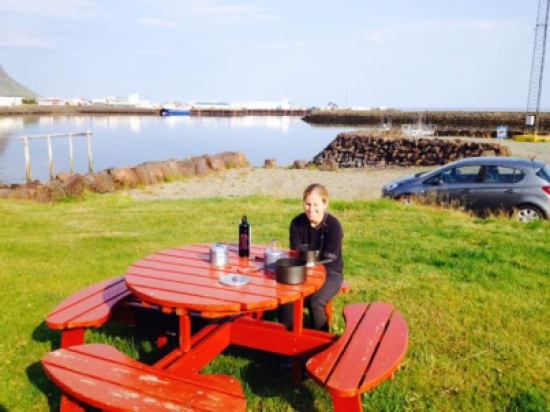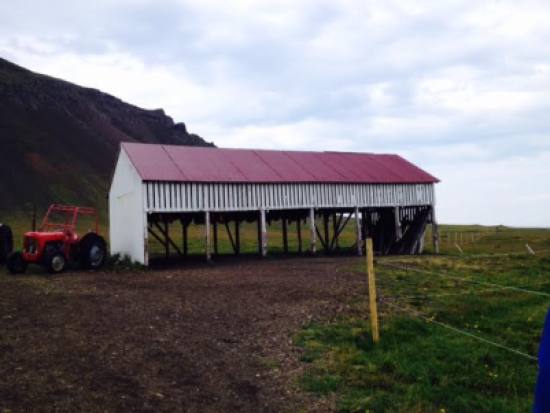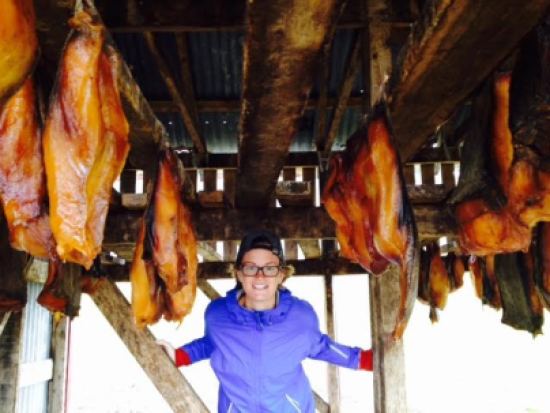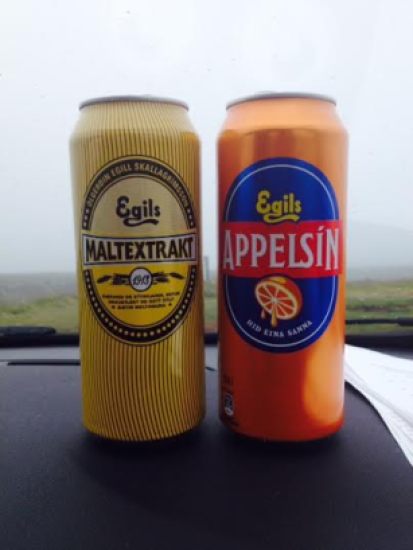Welcome back to the fourth and final installment of our walk down memory lane. Today’s post will provide some applicable life hacks to lower your trip expense if you decide to visit Iceland or Norway someday. If you missed the 3 previous posts, here they are:
- Our Honeymoon – Part 1: Exploring The Norwegian Fjords
- Our Honeymoon – Part 2: Circling Iceland
- Our Honeymoon – Part 3: Iceland & Norway – Breakdown of Expenses
If you’re into camping and the outdoors, Norway and Iceland should definitely be on your list of places to go (once traveling internationally becomes safe again of course). Many people associate both of these countries as very expensive destinations – they definitely can be but do not necessarily have to be.
Sleeping/Camping/Showers:
Back in 2015 when we visited, both countries allowed anyone to camp on open land for free as long as it’s not on farmland or personal property, within eyesight of a campground, or in a national park. We made full use of this and camped EVERYWHERE for free. Sadly, I read this article from 2019 that wild camping is no longer allowed in Iceland thanks to people disrespecting the land… not sure if this is 100% accurate, but worth researching before your trip.
We never once felt unsafe and there were tons of rest stops to pull up to and set up camp for the night. And we woke up to amazing expansive million-dollar views each morning. However, if you are set on staying at campsites (or should I say if you’re now required to), I would not waste time researching these online as there are limited campgrounds with websites (at least back when we were planning our trip) yet there are TONS of options along the main roads that you could stay the night at. Most campsites cost ~$10-15 per person per night and are open areas with very minimal trees. The only thing the campsites provided that off-road camping did not was access to restrooms and showers.
Which leads to a question you may be thinking… you ladies spent 2+ weeks camping along the road, how in the world did you shower during your trip? We quickly learned that the cost the campsites charge to use their showers ($3-4 in addition to the nightly rate) was comparable to the entrance to any of the local Sundlaugs (swimming pools). And these are not just normal swimming pools. They are filled with geothermal water so they are extremely clean and pure and likely do not have any chlorine. Note: regardless of how tiny a town is, chances are it has a Sundlaug – look for the blue sign of a head bobbing in water.

Most campsite showers have a time limit or pay per minute feature. Rather than feeling rushed, we decided to pay the 450-600 ISK ($3-5) entrance fee at the various Sundlaugs, showered naked before entering the pools (an absolute must for everyone entering the pools, fine by us to shower with shampoo and soap – that’s the underlying reason why we’re there in the first place!), relaxed for a few hours in the various pools that varied by temperature (lap pools are typically ~28 C and hot pools varying from 38-45 C), showered again, and were on our merry way.
How it works is like this:
- Pay your entrance at the main area
- Go to your respective locker room/shower area but gender
- Undress, take a shower, put your bathing suit on
- Head out to the pools
So you are not naked in the actual pools, just before entering.
We enjoyed the Sundlaug at Akureyri the best as it had 2 lap pools, 4 hot tubs, an ice bath, steam room, sauna, and a few slides for kids. Again, for just a couple of bucks we relaxed here for hours as we waited for the rainy weather to pass. Other Sudlaugs we visited were located in Eglisstadir, Hofn, Kirkjubauer, and Vik.
Thus, the campsites are a good route if you need facilities but you can just as easily camp for free (maybe?) and visit the Sundlaugs for a fraction of the price. I cannot stress how much we enjoyed the Sundlaugs. It’s an essential aspect of Icelandic culture and I’m glad we went to authentic ones rather than the Blue Lagoon which would have been way more expensive than all our Sundlaug experiences combined.
As for restrooms, they can be accessed whenever you drive past a town at a gas station, grocery store, tourist stop, etc.
Car rental vs Tour Groups vs Hitch Hiking?
Car, gas, and tolls, can be very expensive in both countries when you add it all up but this is where we decided to splurge for the freedom to go wherever we wanted when we wanted rather than rely on hitchhiking or tour buses to bring you to a limited number of stops.
Our car proved to be quite useful during some wind gusts where we used the car as shelter. The best car rental price we could find in Bergen in August was $75/day and in Iceland it was $40/day. We used Sixt both times and had a pleasant experience with them.
Gas in Norway was 11 NOK/liter (~$1.50/liter or $4.50/gallon) and in Iceland gas cost us 205 ISK/liter ($1.62/liter or $4.88/gallon). Tolls are very frequent in Norway and can quickly add up and there is only 1 toll (1,000 ISK or $7.50 USD) in Iceland located northwest of Reykajavik.
We found the driving conditions in Norway to be quite scarier than in Iceland. The city roads are quite normal with many roundabouts but once you are in the Norwegian countryside, the road turns into one lane especially around sharp corners, bridges, and tunnels. And they are narrow (compared to North American standards at least)!
If you are only staying in Bergen, no need to rent a car as the city is very walkable and you can take the Flybussen bus from the Bergen airport into the city center for $12 USD per person (or $20 USD round trip). We rented a car for 2 days to get to Odda and hike Trolltunga (definitely recommend this exhausting hike to anyone capable!) and returned the car at the Sixt location 3 km from the Bergen city center and walked back into the city.
Our car in Iceland was supposed to be a manual but we were upgraded to an automatic which turned out to be quite nice as you spend a few hours a day driving and manual could get exhausting for someone not keen to driving a manual (and it had a USB charger which was clutch for our electronics – this was not a standard setup back in 2015 ha!).
Driving in Iceland is quite pleasant as Ring Road is very well paved and not crowded once you leave Reykjavik. Reykjavik can be a bit trickier with the roundabouts and traffic, but definitely manageable. Most rental cars (ours included) do not allow you to go on F-roads where special off-road cars only are allowed. We somehow managed to get a flat tire on the way back to Ring Road from Pakgil (we would recommend driving out here for the scenery alone if you are in Vik even if you’re not planning on camping there). Fortunately, the tire lasted until we got to a gas station in Vik, which is where we actually first realized the tire was punctured. Considering how vast and barren Iceland is, it couldn’t have been better a location to get a flat as the gas station attendant let us use their phone to call the car rental and he also showed us a map of a car repair shop located only 4 blocks away. Within an hour we (…. err Nic) put on the spare, drove to the garage, patched the tire, paid 5900 ISK ($45), and were on our merry way again.
While we were researching for Iceland, we noticed many people had questions about hitchhiking or biking around the country. Here’s our two cents on the topic after witnessing people doing both first hand: we would not recommend either option. We say this not in fear of your safety or well-being but more so for your comfort. It seemed hitchhikers were getting picked up pretty quickly and easily, but with Iceland’s sporadic weather you will truly appreciate having your own car rental when a wind storm passes through. We also feel like you’d end up spending more time trying to find a ride than enjoying the sites and having the freedom to stop off wherever you please. As for biking, it may seem like a good idea upfront but again be prepared for some crazy weather. If you are a very tight budget and have time to spare, hitchhiking or biking may be for you. But for the cost of a rental car, you have the freedom to do as you please, when you please. If you go this route, ensure you have the proper equipment and clothing!
If we could go back in time, we would have gone the camper van route vs a car rental. Camper vans were very common along Ring Road and they would have provided a more comfortable sleeping arrangement.
Food
We are the type of people to find a grocery store and eat like the locals versus finding restaurants to scout out. We tried a few restaurants throughout the trip where we tasted reindeer, farm-fresh hamburgers and ice cream, harkarl (fermented rotten shark – yes, it tastes as lovely as it sounds), puffin, and minke whale. Otherwise, we stuck to the grocery stores, namely Kiwi in Norway and Bonus in Iceland. We brought along some cooking gear and purchased some butane gas at the N1 gas station (note for those camping – if you are looking for propane or butane to cook your meals, head to the gas stations!). We used a 500-gram container of butane, purchased from N1 for $13, which lasted for all of our meals. We brought some staples from North America – granola bars, coffee, pasta, soups, peanut butter but all of these items could have easily purchased in either country.
As for grocery stores, we recommend Bonus in Iceland and Kiwi in Norway. There are many Bonus locations within Reykjavik, and they can also be found in Borganes, Stykkisholmur, Akureyri, Eglisstadir, Selfoss, and Hveragerdi. Other towns with other grocery stores are Hofn, Vik, Bolondus, etc. which have either Netto, Kjarval, Urval, Kronan. These stores can be a little more expensive than Bonus but still viable options. Our point is, stock up for a few days (depending on how long you are planning to take in between towns) but you’ll be able to find a grocery store relatively easily.
Dairy products are pretty cheap – a liter of whole milk is 120 ISK ($1), yogurts are 100 ISK, skyr (tastes and consumed just like a thick Greek yogurt but it’s actually a sour milk cheese and becoming more and more popular globally these days) 150 ISK, Brie cheese 294 ISK. For whatever reason, Swiss cheese was the cheapest in Norway yet quite expensive in Iceland.
If you’re looking to try out a typical Icelandic snack – fish jerky – check out the Bonus in Akureyri for the best price (500 ISK for 100 grams). Personally, we thought this was terrible.
Other examples of food prices are crackers 96 ISK, a loaf of cake/bread 300-400 ISK, Pagen gifflar cinnamon rolls (very popular with locals and quite tasty in our opinion too) 350-400 ISK, 200g of fried onions for 100 ISK. Fruit is not too expensive (except for berries) but we found they either didn’t taste great or went bad very easily. Carrots were our go-to “healthy” snack 298 ISK for a 1 kg package.
You can also buy food in gas stations (we seemed to prefer N1 for whatever reason) but expect to pay about 2-3x more than a grocery store. Many gas stations within Reykjavik have restaurants connected to them. A common snack is to get a gas station hot dog (plysur) which is served with both raw onions and fried onions. You can add mustard (which is more like a brown bean sauce – and surprisingly good), remoulade/mayo, and ketchup. Expect to pay 300 ISK or 450 ISK if you want bacon-wrapped. There is also a “famous” hotdog stand in Reykjavik that sells hot dogs. In our opinion, all the hot dogs tasted about the same and we didn’t really find anything too amazing about them, but they were good.
Side note on getting gas – most gas stations require a pin at the pump so if your credit card doesn’t have one you can go inside and pay with the cashier as long as the store is open. This then leads to the topic of Iceland having very atypical operating hours at most facilities. Most places don’t open until 10:00 or 11:00 am and close by 8:00 pm. Some Vinbudin (see below) are only open 2 hours a day (4:00-6:00 pm). Just something to keep in mind so you don’t run out of gas (or alcohol)!
We asked a few locals about the food they eat and many recommended hamburgers, hot dogs, or pizza. Oy. Sadly, be prepared to see many Americanized food options. Norway has McDonalds but there aren’t any in Iceland. Instead, you’ll find KFC, Quiznos, Subway, and many other restaurants advertising hamburgers, hot dogs, and pizza. Many people eat fish and love fish jerky but the locals prepare these meals at home and insist fish on menus at restaurants are only for tourists. Another common food is harkarl – or fermented rotten shark. We went to the Bjarnahofn shark museum and tasted it ourselves – extremely pungent and tastes like ammonia but apparently the locals eat them like M&Ms.
Our meals consisted mainly of:
- Breakfast: yogurt/ skyr, oatmeal, and coffee or tea
- Lunch: cheese (mostly Swiss in Norway and Brie in Iceland), salami/pepperoni, crackers, fruit, carrots
- Dinner: soup, pasta, tuna
- Snacks: we personally enjoyed Ballerina cookies (think of an Oreo with Nutella in the middle), Paprika chips, and Bacon chips
We bought eight 1 liter water bottles from Bonus for about $1 each and used about 3 a day including cooking/brushing teeth etc. Drinking water is readily available everywhere for free – just make sure it’s cold (glacier) and not hot (sulfur) water. If camping, you’d be more than fine with a maximum of 6 liters of water and can refill every other day.
Alcohol
We tried quite a few types of beer and honestly, we can’t recall them all. They were all local, coming from either Norway, Denmark, Iceland, or the Faroe Islands. We particularly enjoyed Polar Beer lager and Viking lager the best and also enjoyed Denmark’s Somersby blackberry cider. Egils is the main brewery in Reykjavik which produces Gull, Pilsner, Viking, Polar Beer, Sterkur, Applesin, Maltextrakt, etc.
Some grocery stores in Norway and Iceland sell “light” beer but be warned that most times the alcohol content is about 1/2 of what a can from a liquor store will provide. The liquor stores in Iceland are called Vinbudin, and like the Sundlaugs, regardless of how small a town is, chances are it will have a Vinbudin. They may not be on the main road but look for a grey store with 3 red circles on it (looked like grapes to us to signal wine?).

You can buy beer in the typical 6-pack or 12-pack fashion but can also buy single cans as well by taking cans out of a pack. This seemed to be quite popular and we followed suit which allowed us to sample quite a large variety. Beers will cost you about 300 ISK ($2-3) per can in a Vinbudin or $7-8 in a restaurant.
Iceland is also known for alcohol called Brennivin (aka Black Death). It’s a clear schnapps and considered Iceland’s signature distilled beverage. It is made from fermented grain or potato mash and flavored with caraway (licorice). The best place to buy this is in the Duty-Free section at the airport. We bought one and still had it at home 5+ years later. Personally, we are not fans of caraway/licorice so we ended up giving it to Nic’s brother.
Wifi
If you’re out camping you do not have the luxury of connecting to hotel wifi to access the internet. Good! Go enjoy nature instead! That’s what you’re there for anyway, isn’t it? If you absolutely need wifi, it can be a bit hard to find but here are our recommendations:
- some campsites offer wifi for free or for a fee,
- some gas stations will have Vodafone hot spots,
- some Sundlaugs will have wifi for paying patrons,
- the mall in Akureyri has a Vodafone store with free wifi,
- some visitor centers have Vodafone hot spots (example: Skaftafell) whereas some have wifi for customers only but even that didn’t work (Jokulsarlon) and some you can pay for (Vik info center),
- the best hack is to park next to a tour bus at a tourist location (we found Reykajavik Excursions to be the best) and connect to the buses wifi when you’re by a tourist spot.
We were able to get around both countries with the app called Maps.Me. We downloaded the country maps for both Iceland and Norway beforehand while still in Canada and had wifi available to download for free. We had such a good experience with this map platform as it worked just like most GPS programs but completely without data! We could place in a location and it would recognize our starting spot and provide step-by-step directions to get there either via by car or walking.
There you have it! You now have all the insider tips and tricks to keep your trip to Iceland and Norway within budget. And regardless of where you are traveling, you can always load e-books or audiobooks onto your phone/e-reader from your local library prior to heading out to have free entertainment at night. Learn anything useful in this post that you can apply to any future travel plans? As mentioned above, if you missed the 3 previous posts on our 25-day honeymoon to Norway and Iceland, here they are:
- Our Honeymoon – Part 1: Exploring The Norwegian Fjords
- Our Honeymoon – Part 2: Circling Iceland
- Our Honeymoon – Part 3: Iceland & Norway – Breakdown of Expenses
Support This Blog
If you liked this article and want more content like this, please support this blog by sharing it. Not only does it help spread the FIRE, but it lets me know what content you find beneficial. Writing is NOT my strong suit and it honestly takes me hours to write each post so the more encouragement the better! Engaging in the comments below keeps me motivated. You can also support this blog by subscribing to receive emails anytime a new post is published. Thank you FImily!
We believe in stacking up life hacks to keep your enjoyment levels to the max without depleting your bank account. Here are some ways to further educate yourself and save thousands of dollars over your lifetime by making some simple adjustments:
- Investing Newbies: Check out our free Investing 101 Series.
- How much are you paying for your phone plan? Canadians, learn more about Public Mobile, and see how we are paying $3/mo for our cell phone plan.
- How much are you paying for internet? Canadians, learn more about the various Independent Service Providers out there to see who services your area so you can lower your monthly bills.
- How much are you paying for home insurance? We were able to reduce our rates by 25% by switching over to Square One Insurance. If you live in BC, AB, SK, MB, and ON, check out Square One for your home insurance, landlord insurance, and/or tenant insurance. Use this link to receive an extra $15 off your quote. (Note that you must use this link to start the process to get the $15 off even if you prefer to pay over the phone.)
- How much are you paying for your monthly utility bills? See how you can likely save on this monthly expense.

